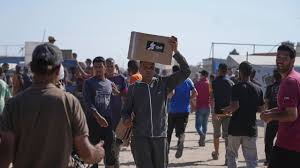US proposes 60-day Gaza ceasefire deal: Israel accepts, Hamas has it under review

The United States has proposed a 60-day ceasefire to halt the ongoing war between Israel and Hamas. Israel has accepted the plan. Hamas is currently reviewing it. This proposal offers a glimmer of hope amid the chaos in Gaza, where the humanitarian crisis is growing by the day.
What’s in the Ceasefire Plan?
The U.S.-backed plan calls for an initial 60-day halt in fighting. It includes prisoner exchanges and access for humanitarian aid. The goal is to create space for long-term peace discussions.
Key points of the proposal include:
- Hamas will release 28 Israeli hostages in the first week. These include both living and deceased individuals.
- Israel will free 125 Palestinian prisoners serving life terms and return the bodies of 180 deceased Palestinians.
- Aid organizations will get immediate access to Gaza to deliver food, medicine, and essential supplies.
- The remaining 30 Israeli hostages would be released only if a permanent truce is agreed upon later.
This plan is the first phase of a larger peace framework. The later stages would include lasting ceasefires and rebuilding efforts.
Israel’s Decision: Under Pressure at Home and Abroad
Prime Minister Benjamin Netanyahu has informed the families of hostages that Israel is ready to proceed with the deal. This marks a shift in Israel’s stance. Until now, the government has avoided large-scale agreements with Hamas during active conflict.
There are several reasons for this change. Weekly protests across Israel have called for action to bring the hostages home. International criticism of Israel’s military campaign is also rising. Domestically, Netanyahu’s coalition faces pressure to show results and avoid more casualties.
Over 1,200 Israelis have died since the conflict began in October 2023. Many believe a temporary truce could help bring closure to some families and reduce immediate tensions.
Hamas’s Concerns: Demands Still Unmet
Hamas hasn’t rejected the plan but has voiced concerns. The group wants a complete Israeli withdrawal from Gaza. They also demand a full and permanent ceasefire.
A Hamas official, Basem Naim, said the deal “does not meet any of our people’s demands, foremost among them, halting the war.” These concerns point to deeper mistrust between the two sides.
However, Hamas’s willingness to review the plan shows some room for negotiation. If regional mediators like Egypt and Qatar step in, they might bridge the gap and encourage progress.
Humanitarian Needs: Situation Is Urgent
The war has caused immense suffering in Gaza. Health officials report more than 54,000 Palestinian deaths. Thousands more have been injured or displaced. Basic services like electricity, water, and healthcare have collapsed.
Gaza’s 2.3 million residents are in desperate need of food, clean water, and medicine. Humanitarian groups warn of famine-like conditions. Hospitals are overwhelmed, and most infrastructure lies in ruins.
If the ceasefire goes ahead, aid will reach Gaza quickly. Relief organizations are standing by to send supplies and rebuild key facilities. But every delay increases the cost in human lives.
Global Response: Cautious Optimism
World leaders have reacted positively to the ceasefire plan. The United Nations and European Union have called it a crucial opportunity. Arab nations like Egypt and Qatar support it and are encouraging Hamas to accept.
U.S. President Joe Biden has personally backed the plan. He sees it as a test of America’s leadership in the region. The administration hopes to show that diplomacy can still solve major conflicts.
Many view this proposal as a rare chance to reduce violence and ease suffering—if both sides can agree.
What Happens Next?
Israel’s acceptance gives the plan momentum. But Hamas’s approval is essential for progress. If they agree, the first phase could begin within days. Hostages would return, prisoners would be released, and aid would flow into Gaza.
However, if Hamas rejects the deal or demands major changes, the plan could collapse. That would likely mean more bloodshed and more delays in humanitarian efforts.
This truce may not solve all issues, but it offers something rare: a chance to pause, breathe, and rethink the future.
Conclusion: Pause or Turning Point?
The U.S.-proposed ceasefire plan could change the course of the Israel-Hamas war. It creates a space for dialogue, aid, and healing. Yet, it’s fragile. The outcome depends on trust, diplomacy, and political courage.
If accepted, the ceasefire could mark the beginning of long-term peace. If not, Gaza and southern Israel may face yet another wave of violence. For now, the world waits—and hopes for a breakthrough.






